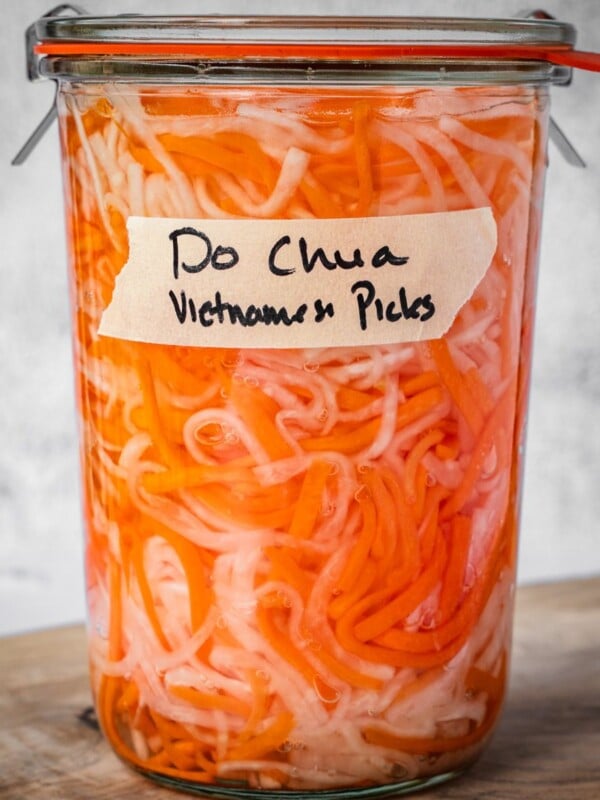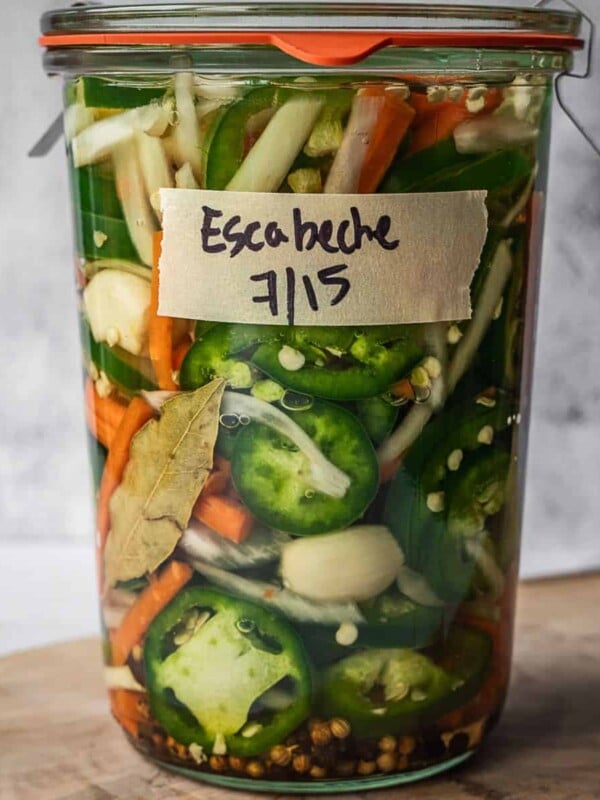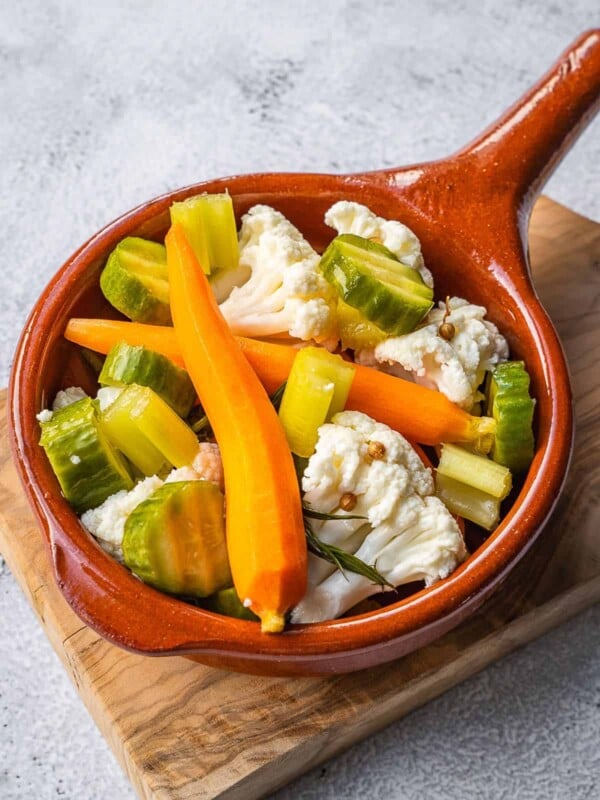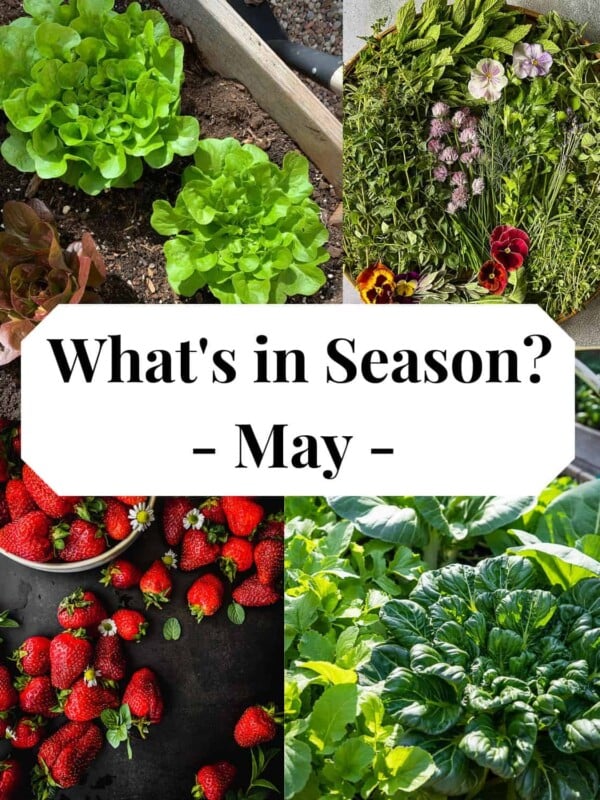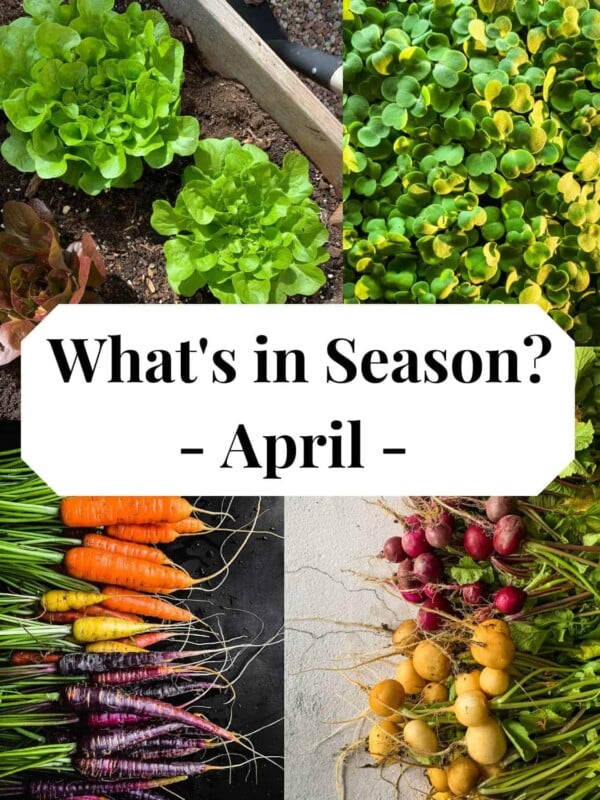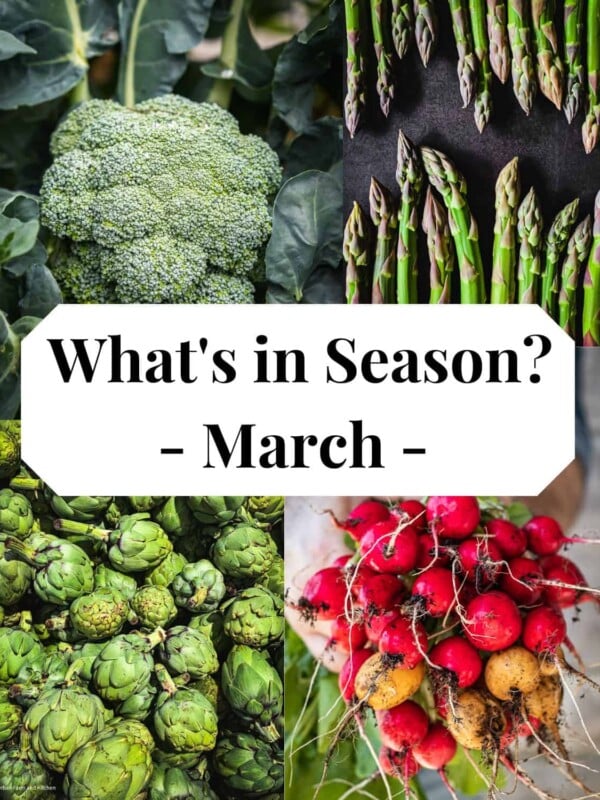June is such a lovely month. It is hopeful with the promise of summer, the longest days of the year, and trees and shrubs in full bloom. We have all waited so long to feel the sunlight sit thick on our cheeks.
And there’s no better way to enjoy June than walking barefoot through the strawberry patch, fingers stained red, rustling through strawberry plants, picking the ripest, juiciest, sweetest berries.
In this blog post, we’ll explore some of the best seasonal produce that you can find during the month of June. This post is the 6th in my Monthly Seasonal Produce Guides series.

Table of Contents
June strawberries are unparalleled in flavor. More than sweetness, they all have their own unique floral tastes. They are my all-time favorite food, and they are here for just a few weeks each year. Eating locally and seasonally makes food special, and it is much more nutritious, as the produce does not have time to lose its nutritional value traveling thousands of miles.
For me, as a cook and a gardener, eating seasonally and eating local go hand in hand. The goal of eating seasonally is so that I can enjoy foods that are harvested as close to home as possible and that didn’t have to travel thousands of miles. This is why I am such a big proponent of homegrown food and edible gardening and why I wrote a book on the subject (Seed to Table).
Much of the produce trucked from far away places is harvested early and forced to ripen before it hits your grocery store produce aisle. Another reason to seek out seasonal food? You’re supporting local farmers and that’s a good thing! So, what’s in season in June?
Strawberries
These red juicy berries, beloved across the world, are at their best from late May through the month of June. Strawberries are high in Vitamin C, antioxidants, and have a low glycemic index. Strawberries are also known for their stress reduction properties.

They are quite delicate, and it’s fairly easy for strawberry season to be disrupted by too much rain and unusually hot temperatures that will cause the berries to turn to mush right out in the fields, so pay attention to local conditions, as not to miss the season.
Strawberries are great eaten on their own and sliced with whipped cream. High in fiber, I will eat them past the point of an upset belly. They are an excellent addition to salads and smoothies and featured in desserts. Try them in a chocolate tahini and coffee smoothie or cook them down on the stovetop with rose wine for a strawberry rose compote.
If you grow strawberries at home, you will learn that the birds, squirrels, bugs, and well, just about everyone loves strawberries, so you’ll have to protect the plants with netting or row covers and fencing and treat plants as needed for insects. After verifying growing practices, especially as far as pesticides go, I prefer to go picking at one of the local farms.
Rhubarb
What would strawberry season be without the rhubarb? Rhubarb is a late spring/early summer vegetable that is very tart. As such, it is usually cooked with sugar in desserts, sauces, and jams. The edible part of the plant is the stalk, which adds nice texture and tartness to strawberry rhubarb desserts.

Rhubarb is high in Vitamin K, fiber, and antioxidants and low in calories. The leaves are actually toxic, so do not eat those!
Sweet Cherries
Sweet cherries are in season for just a few precious weeks from late June through mid-July. Sweet cherries are irresistibly juicy, dying your fingers and wrists a deep shade of red as the juice drips down your hands as they burst with each bite.
Cherries are high in vitamins, minerals, and antioxidants and polyphenols. Cherries also contain melatonin, improving sleep quality. Enjoy eating cherries on their own or in salads or smoothies.
Cherries are fantastic featured in desserts like chocolate cherry scones or the quintessential cherry pie.
Raspberries
Summer-bearing raspberries begin their season mid-June and finish producing mid-July. Raspberries are especially delicate and are best enjoyed as they are ripe. Raspberries are sweet and tart.
Their bright flavor pairs well with lemon and sweet corn. Raspberries can be enjoyed raw, in smoothies, turned to jam, or added to desserts. Nutritionally speaking, these berries provide a high amount of Vitamin C, manganese, fiber, and antioxidants.
Peas
Peas are in season the entire month of June, and fresh peas are a real treat compared to their frozen counterparts. They have more flavor and a crunchier texture.

Peas are high in protein, vitamin C, vitamin K, and fiber, making them a nutritious part of any diet. When I have the opportunity to cook with fresh sweet peas, I like to keep their texture and add them to stir-fry or salads. Their crunch is particularly unique in risotto with the other textures being so soft.
Peas are a cold-weather crop that is easy to grow at home. Peas should be planted up trellises 4-6 weeks before the last frost. They produce their own nitrogen and enrich the soil as they grow.
Radishes
Radishes are a cool-weather crop that are in season through early June. Radishes are buttery with a bite and a nice crunchy texture. They have an extremely high water content, making them a great way to stay hydrated. Radishes are rich in fiber, Vitamin C, and antioxidants.

They are easy to grow at home and grow rapidly; it takes only 3-4 weeks to harvest radishes. Directly sow the seeds when the soil can first be worked and the soil temperature reaches 45°F. Harvest radishes while they are still tender; waiting too long will result in woody, tough radishes.
Try radishes raw in salads or pickled (try my refrigerator pickle recipe) and added to sandwiches. Fermented Radishes are also a treat.
Local spring radishes are available March, April, May and June. Later in the season you will be able to find local Winter Radish varieties like Daikon, Black Spanish and Watermelon Radish which are perfect for Danmuji, Vietnamese pickles, and Korean Radish Kimchi.
Asparagus
Asparagus is a spring vegetable in season through the end of June. Asparagus has a distinct smell and taste; it’s somewhat bitter, tastes really nutty when roasted, and herbal when eaten raw.

Asparagus tastes great eaten raw, sauteed, grilled, roasted, and pickled, and tastes quite different each way. Pair it with lemon and white wine. Add it to a spring vegetable pasta. Serve it on the side of grilled steak or chicken. Asparagus is also highly nutritious, high in Vitamin K, Vitamin A, Vitamin C, folate, and fiber.
Spinach
Spinach is a cold-weather dark, leafy green that is in season March through June. Spinach is easy to grow at home, but deer, rabbits, aphids, leaf miners, and many other insects enjoy eating spinach, so you will want to use netting or row covers and check for pests consistently.

Plant spinach as soon as the ground is workable, and harvest the baby leaves after 6-8 weeks. Spinach grows best between 50°F and 70°F and is growable again in the autumn months.
Spinach is one of the mostly densely nutritious foods and is beneficial to eat every day. It is rich in Vitamin A, Vitamin C, Vitamin K, Vitamin E, folate, riboflavin, Vitamin B6, iron, calcium, magnesium, potassium, manganese, and antioxidants.
Add spinach to smoothies; its mild flavor leaves it tasteless with other strong flavors. Make a spinach salad with strawberries. Throw handfuls of spinach into soups, pastas, and curries. Spinach pairs excellently with eggs and can be added to quiches, frittatas, and omelettes. Try my Spinach Fatayer (Hand Pies).
Broccoli
Broccoli is a cruciferous vegetable in season the whole month of June. It is a cold weather crop planted in early spring that grows best between 60°F and 70° and is fairly easy to grow.
Broccoli is exceedingly nutritious, high in Vitamin K and calcium. Broccoli has almost all of the Vitamin C essential for one day in just one serving.

Broccoli tastes vegetative and bitter raw yet sweet and nutty when it is roasted. It is great as a snack with hummus or served as a side dish steamed or roasted. It’s an excellent addition to curries and pastas, as the florets hold sauce well.
Broccoli pairs amazingly with cheddar; try it in broccoli cheddar soup, mac and cheese, or to dress up a baked potato. Save the stalks and run them in a food processor for easy broccoli rice and a fun way to reduce waste in the kitchen.
Carrots
Carrots are a root vegetable in season from late May to July (spring carrots). They are crispy and sweet with their sweetness accentuated when they are cooked, especially roasted.

Carrots are high in beta-carotene, among many other vitamins and minerals. Carrots are great raw in salads or as a snack. They are an easy addition to soups and stews. Roasted carrots are an excellent side with any meal.
Here are a few of my recipes that feature carrots:
Carrots are easy to grow at home, provided you buy the right seeds for the soil type in your region. To plant carrots in the spring, sow the seeds 2-4 weeks before the last expected frost. A light frost can actually make carrots sweeter because of how the plant turns some of its starches into sugars as a reaction to the cold. To learn more, check out my Carrot Growing Guide.
Cabbage
Cabbage is a cruciferous vegetable that is in season through late spring/early summer. Cabbage is somewhat easy to grow at home. Start cabbage seedlings indoors 6-8 weeks before the last expected frost, and plant the seedlings outside 2-4 weeks before the last expected frost.

Cabbage is prone to pests, so use netting or row covers, and check the plants regularly. Learn more by checking our my Cabbage Growing Guide.
Cabbage is high in Vitamin C, Vitamin K, fiber, and antioxidants. Cabbage tastes both sweet and bitter raw. Its sweetness and nutty flavor are more prominent when it is sauteed or roasted.
Cabbage pairs well with any citrus; try it sauteed with lemon juice, garlic, and parmesan or sauteed with a cilantro lime dressing. Add it to mashed potatoes, cover it with cheddar, and bake it in the oven until the cheese melts. Ferment cabbage into sauerkraut (also try my red cabbage sauerkraut) or kimchi to make it sour and zippy.
Herbs
Herbs come into season in June, and the baby leaves often taste their freshest of the season. Some herbs prefer cooler climates and are ready to harvest in the spring/early summer.

Cilantro should be planted as soon the soil is workable and grows best when it’s cool. Cilantro will bolt and become bitter as soon as the temperatures heat up. Cilantro has a citrusy flavor and goes great in salsas, dressings, and sauces. Check out my Cilantro Grow Guide.
Chives are an herb enjoyed best in the spring when the leaves are still tender. They have a mild oniony taste that pairs great with potatoes and lemon and also other in season vegetables such as carrots and radishes.
Chives are an easy perennial, so plant them in the ground and leave them; they’ll grow fine. The chive blossoms may also be eaten and elevate the presentation of any dish with their pretty light purples.
Dill can also be planted as soon as the soil is workable and grows best in milder temperatures. Dill has a unique taste that is very fresh. It pairs well with lemon, carrots, cabbage, and pickles. Dill is an excellent addition to pasta salads and potato salads to bring to cookouts as outdoor gatherings pick up for the season.
I created a handy graphic for you here. Go ahead and Pin it so you can refer to it again and again.

Disclaimer
Seasonal food is very regionally specific. Something might be in season in California and not in season in New York. For example, strawberries are in season in California year-round. In New York, Ontario, and other parts of the North East, local strawberries will be in season in June and July.
The best way to know your food is in season? Shop at local farmers’ markets and ask questions. Look at the grocery store labels and tags.
Let me know if you have any questions (leave a comment) and follow along on Instagram, Facebook, and Pinterest, visit the Urban Farm Shop, or subscribe for new posts via email.

